Horology: Treasures That Tick
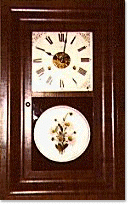 1893 Seth Thomas ogee |
When I was a kid, back in Canton, Ohio, I used to love visiting my Dad's Uncle Carl and Aunt Mary. They were then (and are still) a cheerful, gracious couple who never had any children or grandchildren of their own but were (and are still) universally treasured by their nephews, nieces, grandnephews, and grandnieces. Aunt Mary's claim to fame was that she gave the best hugs in the whole world, but it was always Uncle Carl who held an almost magical fascination for me. He smoked a pipe. He made his own homebrew beer and wine. Later, when I was old enough to understand, he told me stories about his experiences at Guadalcanal, during World War II. But what made the biggest impression on me was his clocks.
Somewhere along the line, people started giving Uncle Carl the filthy, broken-down clocks that they discovered in their attics or basements. He'd apply his ingenuity and a bit of elbow grease, and before long they were ticking along and sitting pretty on the mantel, or on a bracket, or hanging on a wall. By the time
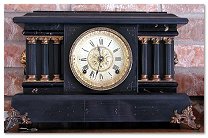 1910 Seth Thomas mantel clock |
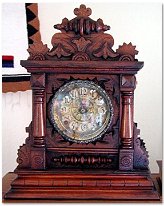 Ingraham mantel clock |
My favorite time to be at Uncle Carl and Aunt Mary's was around noon, because that's when the clocks really put on a show. Maybe five minutes before the hour, I'd hear a camelback mantel clock bong softly from one of the bedrooms. Soon, other clocks in various rooms of the house would "chime in", reaching a crescendo--which I have come to think of as a clockophany--and tapering off again by a couple minutes past the hour.
Soon after I'd purchased my house, I was browsing through an antique shop in Grapevine, Texas. There, I found a 1910 Seth Thomas black pillar mantel clock like the one my grandfather used to have on the mantel at his house. I had no idea whether or not the asking price was fair, but I always figure that if an item is worth the asking price to me, then it's fair. Anyway, the clock was in pristine condition, so I bought it and put it on the mantel above my fireplace, where it continues to keep good time.
 Uncle John's cuckoo |
I currently have six antique clocks of my own: five
running, one not. In addition to the black mantel clock, I have
an 1893 vintage Seth Thomas ogee clock and a medium-sized German
cuckoo clock--which once belonged to my Great Granduncle John Schwitzgebel--both
given to me by Uncle Carl. There are also an Ingraham mantel clock
and the Ansonia* kitchen clock that I bought
as a fixer-upper and got running when I took the beginners' clock
repair class put on by my local Lone
Star #124 chapter of the National Association of Watch and Clock
Collectors (NAWCC).
I hope to eventually learn enough about clock repair to clean and
maintain my own clocks. So far, I haven't gotten any further along
than the beginners' class, but I've picked up a non-running mantel
clock with barrel spring movement so I'll have something to work
on when I find time to take the next class.
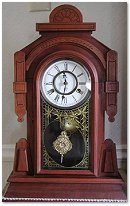 'Ansonia' kitchen clock |
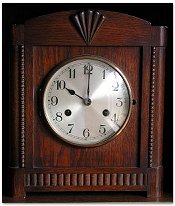 The next project |
* I have since learned how to recognize an Ansonia movement by looking at it. Unfortunately, I didn't have this knack when I bought the clock at auction. Perhaps the seller, who represented it at such, didn't know how to tell either.